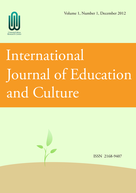


Volume 12 Issues 3-4 (2023-12-31)
Volume 12 Issues 1-2 (2023-06-30)
Volume 10 Issues 1&2 (2021-06-30)
Volume 9 Issues 3&4 (2020-12-31)
Volume 9 Issues 1&2 (2020-06-30)
Volume 8 Issues 3&4 (2019-12-31)
Volume 8 Issues 1&2 (2019-06-30)
Volume 7 Issues 3&4 (2018-12-31)
Volume 7 Issues 1&2 (2018-06-30)
Volume 6 Issues 3&4 (2017-12-31)
Volume 6 Issues 1&2 (2017-06-30)
Volume 5 Issues 3&4 (2016-12-31)
Volume 5 Issues 1&2 (2016-06-30)
Volume 4 Issues 3&4 (2015-12-31)
The purpose of this study was to examine teacher perceptions of the impact of cultural influences on seating arrangements and their impact on student systematic learning in the classroom. Specifically, the following five research questions guided the study: a) What is the impact of different seating arrangements on student systematic learning in the classroom? b) What is the relationship between seating location and student motivation? c) What is the relationship between seating arrangements and student achievement? d) How do seating arrangements affect social interactions within the classroom? And e) what are the similarities and differences in the impact of seating arrangements on student systematic learning in the classroom across China and North America? Data were collected from both the Eastern (i.e., the People’s Republic of China) and the Western (i.e., the United States of America and Canada) cultural contexts. The research instrument used for this study was a survey containing twenty 5-point Likert scale items, one rank order item, and three open-ended questions. Results show there is a deeply embedded difference in cultural factors affecting teachers’ perceptions of seating arrangements and their impact on student systematic learning in the classroom. Important educational implications are discussed.
The aim of the present study is to determine which factors promote learning among students of Ethiopian origin and how these students perceive their studies in a matriculation preparatory program in terms of their integration within Israeli society (in the present and future). In addition, an attempt is made to analyze these perceptions in order to examine the model of their integration in the program in particular and in society in general. Twenty students (11 females and 9 males) participated in the study. They were randomly chosen from 87 students enrolled in a two-year matriculation preparatory program at a college located in central Israel. Semi-structured open interviews were conducted with the students. Interview analysis pointed to three main factors which encourage students to continue their studies in the program: military service, family support, and the desire to advance in Israeli society. In addition, a sense of discrimination against the population of Ethiopian origin in general, even if not all had experienced it personally, was raised in interviews. It appears that most of the interviewees in this study behave according to the integration model. Finally, the study offers important suggestions.
The purpose of this investigation is to determine what relationships exist between college students and personality disorders. The research examines the lack of existing literature on the topic as well as the overall relationship between college students and specific personality disorders. Further, the research comes at a time when a noted rise in personality disorders, traits, and features has been noted. Among students who participated (N = 351), a relationship was found between the participants and a number of personality disorders, most notably histrionic personality disorder and narcissistic personality disorder. However, an independent t-test showed no significant difference between the clinical and nonclinical samples, of these and some other personality disorders, suggesting that personality disorders may be more prevalent in the general college population than has been suggested. The researchers discuss the possible reasons for the significant findings and discuss the implications for counseling centers, specifically those centers located on college/university campuses.
What constitutes the professional knowledge base of a competent secondary mathematics teacher? In order to prepare students to compete globally in a world that relies heavily on using mathematics confidently and in a competent manner, a clear understanding of the professional knowledge base of a competent mathematics teacher is required. The paper brings into clear focus the professional competencies required to enculturate students mathematically. These competencies were delineated after a careful analysis of literature from 1980-2010. The professional knowledge base and the required competencies for effective mathematics instruction discussed in the paper can be used to develop a competency instrument to analyze classroom practice, teacher’s knowledge and identify quality in teaching of mathematics. The paper underscores the importance of revision in the curriculum of teacher preparation programs in the aftermath of No Child Left Behind Legislation and the current focus on improving the content knowledge of teachers due to increased emphasis on common core standards.